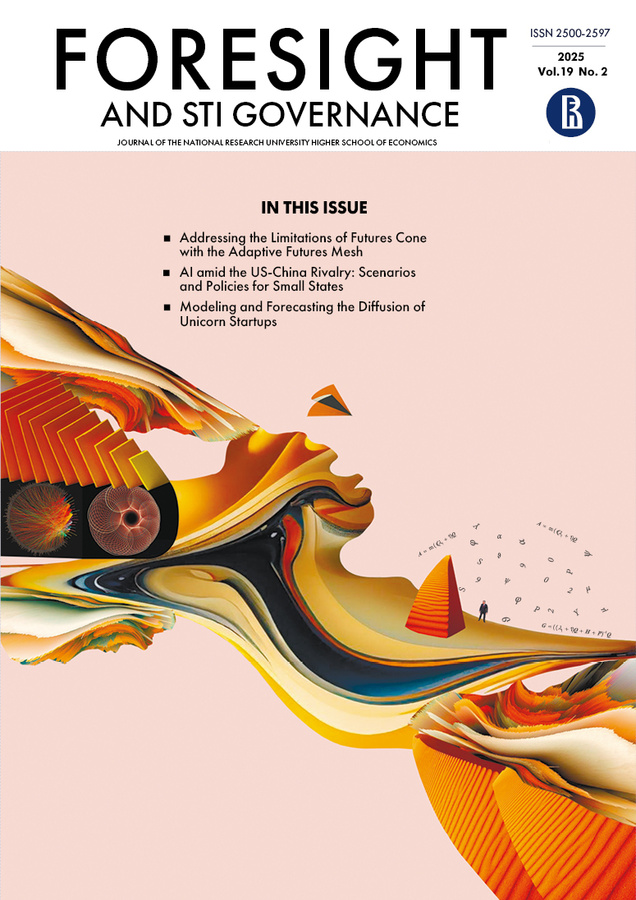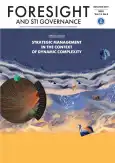Cooperative Strategies in the Age of Open Innovation: Choice of Partners, Geography and Duration
- Authors: Vlasova V.1, Roud V.1
-
Affiliations:
- HSE University
- Issue: Vol 14, No 4 (2020)
- Pages: 80-94
- Section: NETWORKING
- URL: https://journal-vniispk.ru/1995-459X/article/view/346970
- DOI: https://doi.org/10.17323/2500-2597.2020.4.80.94
- ID: 346970
Cite item
Abstract
About the authors
Valeriya Vlasova
HSE University
Email: vvvlasova@hse.ru
Vitaliy Roud
HSE University
Email: vroud@hse.ru
References
- Arranz N., de Arroyabe J.C.F. (2008) The choice of partners in R&D cooperation: An empirical analysis of Spanish firms // Technovation. Vol. 28. № 1-2. Р. 88-100. DOI:https://doi.org/10.1016/j.technovation.2007.07.006
- Aschhoff B., Schmidt T. (2008) Empirical evidence on the success of R&D cooperation - happy together? // Review of Industrial Organization. Vol. 33. № 1. P. 41-62. DOI:https://doi.org/10.1007/s11151-008-9179-7
- Balland P.A., Boschma R., Crespo J., Rigby D.L. (2019) Smart specialization policy in the European Union: Relatedness, knowledge complexity and regional diversification // Regional Studies. Vol. 53. № 9. P. 1252-1268. DOI:https://doi.org/10.1080/00343404.2018.1437900
- Barney J.B. (2001) Resource-based theories of competitive advantage: A ten-year retrospective on the resource-based view // Journal of Management. Vol. 27. № 6. Р. 643-650. DOI:https://doi.org/10.1177/014920630102700602
- Becker W., Dietz J. (2004) R&D cooperation and innovation activities of firms - evidence for the German manufacturing industry // Research Policy. Vol. 33. № 2. Р. 209-223. DOI:https://doi.org/10.1016/j.respol.2003.07.003
- Belderbos R., Carree M., Diederen B., Lokshin B., Veugelers R. (2004) Heterogeneity in R&D cooperation strategies // International Journal of Industrial Organization. Vol. 22. № 8-9. Р. 1237-1263. DOI:https://doi.org/10.1016/j.ijindorg.2004.08.001
- Belderbos R., Carree M., Lokshin B. (2004) Cooperative R&D and firm performance // Research Рolicy. Vol. 33. № 10. Р. 1477-1492. DOI:https://doi.org/10.26481/umamet.2004020
- Bessonova E., Gonchar K. (2019) How the innovation-competition link is shaped by technology distance in a high-barrier catch-up economy // Technovation. Vol. 86. P. 15-32. DOI:https://doi.org/10.1016/j.technovation.2019.01.002
- Boschma R. (2005) Proximity and innovation: A critical assessment // Regional Studies. Vol. 39. № 1. P. 61-74. DOI:https://doi.org/10.1080/0034340052000320887
- Breschi S., Malerba F., Orsenigo L. (2000) Technological regimes and Schumpeterian patterns of innovation // Economic Journal. Vol. 110. № 463. P. 388-410. DOI:https://doi.org/10.1111/1468-0297.00530
- Caloghirou Y., Kastelli I., Tsakanikas A. (2004) Internal capabilities and external knowledge sources: complements or substitutes for innovative performance? // Technovation. Vol. 24. № 1. P. 29-39. DOI:https://doi.org/10.1007/s12130-005-1005-z
- Carlsson S., Corvello V., Schroll A., Mild A. (2011) Open innovation modes and the role of internal R&D // European Journal of Innovation Management. Vol. 14. № 4. P. 475-495. DOI:https://doi.org/10.1108/14601061111174925
- Castellacci F. (2008) Technological paradigms, regimes and trajectories: Manufacturing and service industries in a new taxonomy of sectoral patterns of innovation // Research Policy. Vol. 37. № 6-7. P. 978-994. DOI:https://doi.org/10.1016/j.respol.2008.03.011
- Chesbrough H. (2012) Open innovation: Where we've been and where we're going // Research-Technology Management. Vol. 55. № 4. P. 20-27. DOI:https://doi.org/10.5437/08956308x5504085
- Chesbrough H.W. (2003) Open innovation: The new imperative for creating and profiting from technology. Boston, MA: Harvard Business Press.
- Cohen W.M., Levinthal D.A. (1990) Absorptive capacity: A new perspective on learning and innovation // Administrative Science Quarterly. Vol. 35. № 1. P. 128-152. DOI:https://doi.org/10.2307/2393553
- Dachs B., Ebersberger B., Pyka A. (2008) Why do firms cooperate for innovation? A comparison of Austrian and Finnish CIS3 results // International Journal of Foresight and Innovation Policy. Vol. 4. № 3-4. P. 200-229. DOI:https://doi.org/10.1504/ijfip.2008.017577
- Dahlander L., Gann D.M. (2010) How open is innovation? // Research Policy. Vol. 39. № 6. P. 699-709. DOI:https://doi.org/10.1016/j.respol.2010.01.013
- De Faria P., Lima F., Santos R. (2010) Cooperation in innovation activities: The importance of partners // Research Policy. Vol. 39. № 8. P. 1082-1092. DOI:https://doi.org/10.1016/j.respol.2010.05.003
- Edquist C. (2011) Design of innovation policy through diagnostic analysis: Identification of systemic problems (or failures) // Industrial and Corporate Change. Vol. 20. № 6. P. 1725-1753. DOI:https://doi.org/10.1093/icc/dtr060
- Fagerberg J., Mowery D.C., Nelson R.R. (eds.) (2005) The Oxford Handbook of Innovation. Oxford (UK): Oxford University Press. DOI:https://doi.org/10.1093/oxfordhb/9780199286805.001.0001
- Freeman C. (1987) Technology policy and economic performance: Lessons from Japan. London: Pinter.
- Fritsch M., Lukas R. (2001) Who cooperates on R&D? // Research Policy. Vol. 30. № 2. P. 297-312. DOI:https://doi.org/10.1016/s0048-7333(99)00115-8
- Godin B. (2006) The linear model of innovation: The historical construction of an analytical framework // Science, Technology and Human Values. Vol. 31. № 6. P. 639-667. DOI:https://doi.org/10.1177/0162243906291865
- Godin B. (2008) Innovation: The history of a category. Project on the Intellectual History of Innovation Working Paper № 1. Quebec: Institut national de la recherche scientifique.
- Gokhberg L., Kuznetsova T. (2015) Russian Federation // UNESCO Science Report: Towards 2030 / Ed. S. Schneegans. Paris: UNESCO. P. 343-363.
- Greco M., Grimaldi M., Cricelli L. (2016) An analysis of the open innovation effect on firm performance // European Management Journal. Vol. 34. № 5. P. 501-516. DOI:https://doi.org/10.1016/j.emj.2016.02.008
- Hayter C.S., Nelson A.J., Zayed S., O'Connor A.C. (2018) Conceptualizing academic entrepreneurship ecosystems: A review, analysis and extension of the literature // Journal of Technology Transfer. Vol. 43. № 4. P. 1039-1082. DOI:https://doi.org/10.2139/ssrn.3137406
- Humphrey J., Schmitz H. (2002) How does insertion in global value chains affect upgrading in industrial clusters? // Regional Studies. Vol. 36. № 9. P. 1017-1027. DOI:https://doi.org/10.1080/0034340022000022198
- Kaufmann A., Todtling F. (2001) Science-industry interaction in the process of innovation: The importance of boundary-crossing between systems // Research Policy. Vol. 30. № 5. P. 791-804. DOI:https://doi.org/10.1016/s0048-7333(00)00118-9
- Kim Y., Vonortas N.S. (2014) Cooperation in the formative years: Evidence from small enterprises in Europe // European Management Journal. Vol. 32. № 5. P. 795-805. DOI:https://doi.org/10.1016/j.emj.2014.02.003
- Kline S., Rosenberg N. (1986) The positive sum strategy: Harnessing technology for economic growth. Washington, DC: National Academy Press.DOI:https://doi.org/10.17226/612.
- Kratzer J., Meissner D., Roud, V. (2017) Open innovation and company culture: Internal openness makes the difference // Technological Forecasting and Social Change. Vol. 119. P. 128-138. DOI:https://doi.org/10.1016/j.techfore.2017.03.022
- Laursen K., Salter A. (2006) Open for innovation: the role of openness in explaining innovation performance among UK manufacturing firms // Strategic Management Journal. Vol. 27. № 2. P. 131-150. DOI:https://doi.org/10.1002/smj.507
- Lee K. (2020) Openness and innovation in online higher education: A historical review of the two discourses // Open Learning: The Journal of Open, Distance and e-Learning. P. 1-21. DOI:https://doi.org/10.1080/02680513.2020.1713737
- Leydesdorff L., Rotolo D., de Nooy W. (2013) Innovation as a nonlinear process, the scientometric perspective, and the specification of an ‘innovation opportunities explorer // Technology Analysis and Strategic Management. Vol. 25. № 6. P. 641-653. DOI:https://doi.org/10.1080/09537325.2013.801948
- Lhuillery S., Pfister E. (2009) R&D cooperation and failures in innovation projects: Empirical evidence from French CIS data // Research Policy. Vol. 38. № 1. P. 45-57. DOI:https://doi.org/10.1016/j.respol.2008.09.002
- Lundvall B.A. (1992) National Systems of Innovation. Towards a Theory of Innovation and Interactive Learning. London: Pinter.
- Nambisan S., Wright M., Feldman M. (2019) The digital transformation of innovation and entrepreneurship: Progress, challenges and key themes // Research Policy. Vol. 48. № 8. P. 1-9. DOI:https://doi.org/10.1016/j.respol.2019.03.018
- Nelson R. (ed.) (1993) National Innovation Systems. New York: Oxford University Press.
- Nieto M.J., Santamaria L. (2007) The importance of diverse collaborative networks for the novelty of product innovation // Technovation. Vol. 27. № 6-7. P. 367-377. DOI:https://doi.org/10.1016/j.technovation.2006.10.001
- OECD (2015) The future of productivity. Joint Economics Department and the Directorate for Science, Technology and Innovation Policy Note. Paris: OECD. DOI:https://doi.org/10.1787/9789264248533-en
- OECD, Eurostat (2018) Oslo Manual 2018: Guidelines for Collecting, Reporting and Using Data on Innovation (4th ed.). Paris: OECD. DOI:https://doi.org/10.1787/24132764
- Perkmann M., Walsh K. (2007) University-industry relationships and open innovation: Towards a research agenda // International Journal of Management Reviews. Vol. 9. № 4. P. 259-280. DOI:https://doi.org/10.1111/j.1468-2370.2007.00225.x
- Plewa C., Korff N., Baaken T., Macpherson G. (2013) University-industry linkage evolution: An empirical investigation of relational success factors // R&D Management. Vol. 43. № 4. P. 365-380. DOI:https://doi.org/10.1111/radm.12021
- Rosenbloom R.S., Spencer W.J. (1996) The transformation of industrial research // Issues in Science and Technology. Vol. 12. № 3. P. 68-74.
- Roud V., Vlasova V. (2020) Strategies of industry-science cooperation in the Russian manufacturing sector // Journal of Technology Transfer. Vol. 45. № 3. P. 870-907. DOI:https://doi.org/10.1007/s10961-018-9703-3
- Srholec M. (2015) Understanding the diversity of cooperation on innovation across countries: Multilevel evidence from Europe // Economics of Innovation and New Technology. Vol. 24. № 1-2. P. 159-182. DOI:https://doi.org/10.1080/10438599.2014.897864
- Teece D.J. (2007) Explicating dynamic capabilities: The nature and microfoundations of (sustainable) enterprise performance // Strategic Management Journal. Vol. 28. № 13. P. 1319-1350. DOI:https://doi.org/10.1002/smj.640
- Tether B.S. (2002) Who co-operates for innovation, and why: An empirical analysis // Research Policy. Vol. 31. № 6. P. 947-967. DOI: 0.1016/S0048-7333(01)00172-X.
- Torre A. (2008) On the role played by temporary geographical proximity in knowledge transmission // Regional Studies. Vol. 42. № 6. P. 869-889. DOI:https://doi.org/10.1080/00343400801922814
- Van Beers C., Zand F. (2014) R&D cooperation, partner diversity, and innovation performance: An empirical analysis // Journal of Product Innovation Management. Vol. 31. № 2. P. 292-312. DOI:https://doi.org/10.1111/jpim.12096
- Wang C.H., Chang C.H., Shen G.C. (2015) The effect of inbound open innovation on firm performance: Evidence from high-tech industry // Technological Forecasting and Social Change. Vol. 99. P. 222-230. DOI:https://doi.org/10.1016/j.techfore.2015.07.006
- Wernerfelt B. (1984) A resource-based view of the firm // Strategic Management Journal. Vol. 5. № 2. P. 171-180. DOI:https://doi.org/10.1002/smj.4250050207
- Yakovlev A. (2014) Russian modernization: Between the need for new players and the fear of losing control of rent sources // Journal of Eurasian Studies. Vol. 5. № 1. P. 10-20. DOI:https://doi.org/10.1016/j.euras.2013.09.004
- Быкова А.А., Молодчик М.А. (2009) Практики открытых инноваций в России: эмпирическое исследование инновационного поведения предприятий Пермского края // Корпоративные финансы. Т. 3. № 3. C. 77-93. DOI:https://doi.org/10.17323/j.jcfr.2073-0438.3.3.2009.77-93
- Дежина И., Медовников Д., Розмирович С. (2018) Оценки спроса российского среднего технологического бизнеса на сотрудничество с вузами // Журнал новой экономической ассоциации. Т. 4. № 36. С. 81-105. DOI:https://doi.org/10.31737/2221-2264-2017-36-4-4
- Кузнецова Т.Е., Рудь В.А. (2013) Конкуренция, инновации и стратегии развития российских предприятий (результаты эмпирических исследований) // Вопросы экономики. № 12. С. 86-108. DOI:https://doi.org/10.32609/0042-8736-2013-12-86-108
- НИУ ВШЭ (2019) Индикаторы инновационной деятельности: 2019. Статистический сборник. М.: НИУ ВШЭ.
- Рудь В., Фурсов К. (2011) Роль статистики в дискуссии о научно-технологическом и инновационном развитии // Вопросы экономики. № 1. С. 138-150. DOI:https://doi.org/10.32609/0042-8736-2011-1-138-150
- Симачев Ю.В., Кузык М.Г., Фейгина В.В. (2014) Взаимодействие российских компаний и исследовательских организаций в проведении НИОКР: третий не лишний? // Вопросы экономики. № 7. С. 4-34. DOI:https://doi.org/10.32609/0042-8736-2014-7-4-34
- Теплых Г.В. (2015) Драйверы инновационной активности промышленных компаний в России // Прикладная эконометрика. № 2 (38). С. 83-110.
Supplementary files









